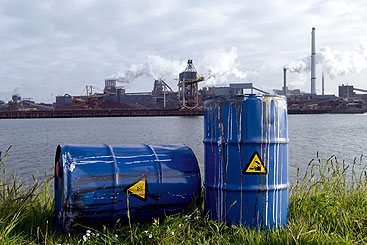Europe looks to the Danube Basin for guidance

Europe looks to the Danube Basin for guidance
A new activity to develop the technical guidelines for the establishment of an inventory on discharges, emissions and losses proposes to put the Danube in the spotlight as a case study for priority substances.

Hazardous substances can remain in the environment for a very long time, and harm ecosystems and human health.
The Danube Countries, together under the ICPDR, have a long history of successful cooperation. In fact, the region is known internationally as a model for integrated river basin management. In 2007 the ICPDR won the International Theiss Riverprize for excellence in water management, one of the most highly regarded international water management awards. Today, the transboundary cooperation and coordination reached through the ICPDR are a great success for the most international river basin in the world.
PRIoRITy subsTaNCes uNdeR The
eu WaTeR fRaMeWoRk dIReCTIVe
The Priority Substances Directive was adopted in December 2008 to protect the environment and human health by setting limits for certain substances and groups of substances that are known to pose a substantial risk to the aquatic environment.
As part of the EU Water Framework Directive, a European ‘priority list’ of substances posing a threat to or via the aquatic environment was established.
There are currently 33 substances or groups of substances on this priority list, which was agreed in 2001, and the list will be reviewed regularly.. These substances are referred to as ‘priority substances’, and those which are thought to pose the greatest threat are further identified as ‘priority hazardous substances’.
The objectives of the Water Framework Directive include the aim to achieve ‘good chemical status’ for surface water bodies by 2015. A water body will obtain ‘good chemical status’ if it meets all of the environmental quality standards for priority substances and certain other pollutants. Further Water Framework Directive obligations aim to:
reduce discharges, emissions and losses of priority substances to surface water bodies and
stop or phase out discharges, emissions and losses of priority hazardous substances to surface water bodies.
The Environmental Quality Standards Directive (EQSD) sets out environmental quality standards concerning the presence in surface water of certain pollutants and substances or groups of substances identified as priority on account of the substantial risk they pose to or via the aquatic environment.
For each river basin, Member States must establish an inventory of emissions, discharges and losses of all substances identified in this Directive. Using this inventory then, the European Commission can determine whether countries are reaching the objectives of gradually reducing pollution from priority substances and stopping or phasing out emissions, discharges and losses of priority hazardous substances.
Now the Danube Basin will serve as a case study to develop guidance for the establishment of a new inventory on discharges, emissions and losses in line with the EU Water Framework Directive.
Understanding current methods. To create the guidelines, Danube countries will create a harmonised basin-wide methodology for the inventory of emissions, discharges and losses. As an initial step, a questionnaire has been drafted to gather information on planning and preparatory work under way, water quality standards and emission data.
Currently, there are a lot of differences in how the Danube countries collect emissions data. “It is essential to harmonise methodology to facilitate the interpretation of results,” says Mihaela Popovici, Technical Expert for Pollution Control at the ICPDR Secretariat.
Linking existing registers. Danube countries will establish a link between this new inventory and those already established to avoid any reporting burdens. The European Pollutant Release and Transfer Register (EPRTR) is the Europe-wide register that provides easily accessible key environmental data from industrial facilities in EU Member States and in Iceland, Liechtenstein and Norway. It replaces and improves upon the previous European Pollutant Emission Register (EPER). An interface is expected to be created to avoid duplication.
Broadening the knowledge of pollution. It will be necessary to improve and expand knowledge of the sources, pathways, discharges and losses of priority substances to allow the identification of targeted and effective control measures. The ICPDR has had a Danube list of priority substances since 2001; however this list needs to be updated to correct the data gaps that exist for some countries.
The ICPDR taking the lead. The ICPDR’s Pressures & Measures Expert Group will serve as the implementing platform for the case study and will test the guidance on priority substances under preparation right now by the Drafting Group of the EU.
Leading the activity as a case study will be an honour for the Danube countries and certainly bring greater attention to the Danube Basin. “Other countries will learn from our testing results,” says Popovici, as the results will shape future decisions.





